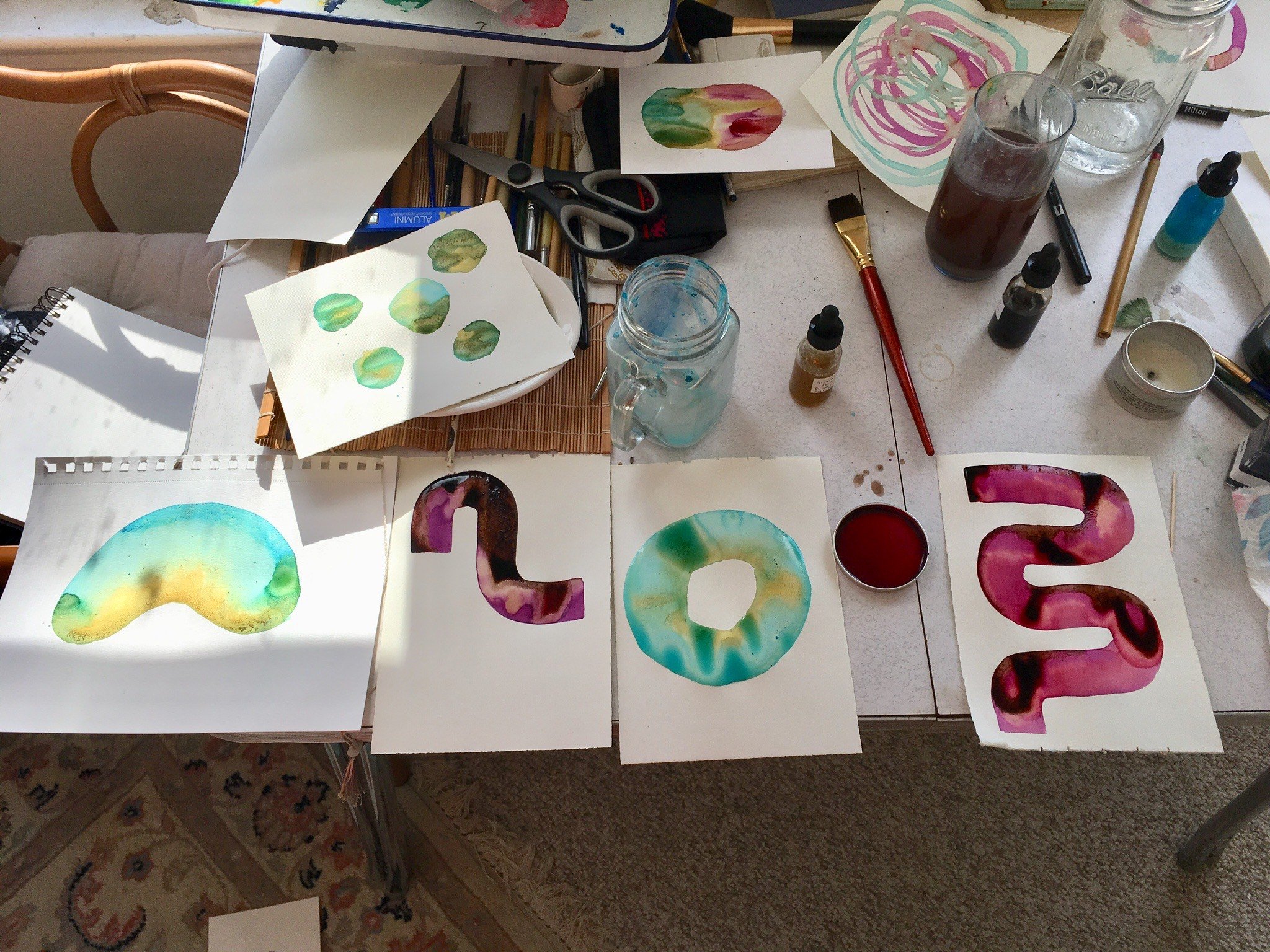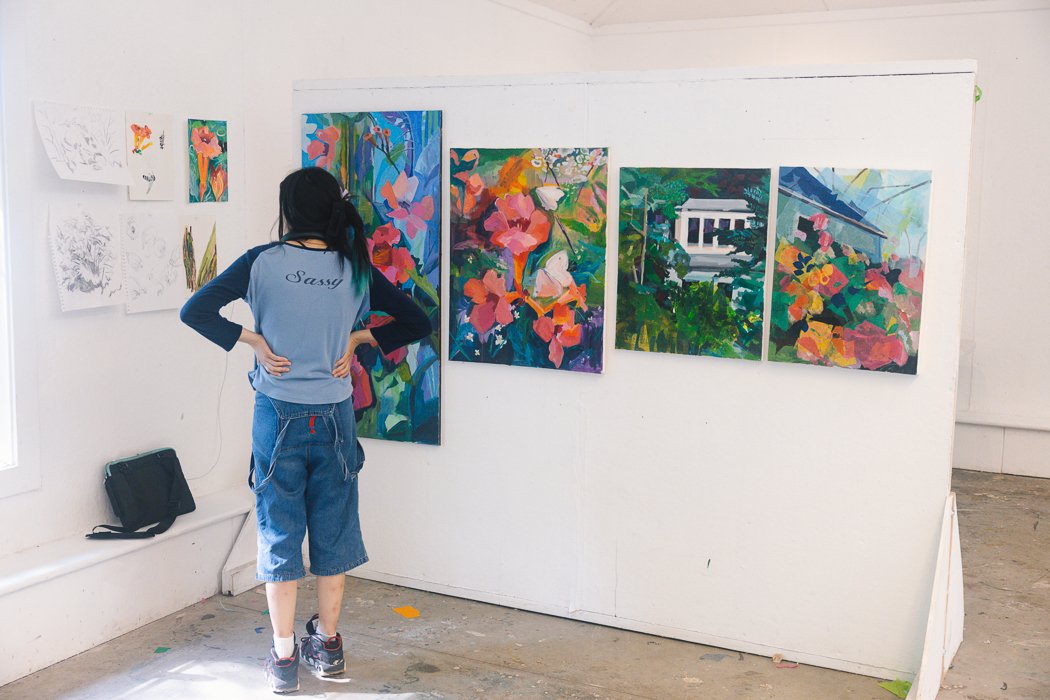On problem solving and experimentation in the print studio.
During the quiet month of March, three creatives brought a spark to Ox-Bow’s campus. The trio was composed of Alex Chitty and the two founders of Process/Process, which produces and publishes new limited edition original prints in collaboration with artists. Process/Process is comprised of Angee Lennard, a seasoned printer who brings the editions to life in the studio, and Jessica Cochran who relishes the program development and curatorial nature of publishing. Founded in 2024, Process/Process has already worked with over a dozen artists to produce prints in limited editions.
Angee Lennard and Alex Chitty consider their initial prints together in the Works on Paper Studio located on Ox-Bow’s main campus. Photo by Hannah Bugg, Digital Communications Assistant.
Prior to their arrival at Ox-Bow's Works on Paper Studio, Alex Chitty and Process/Process had been in conversation over several months, trading ideas on projects Alex had in mind that could take the form of a new print edition. Cochran explained this as a core element of Process/Process. At the beginning stages, she describes the relationship with artists as organic. Cochran elaborated, “we often start [by] talking through studio visits… and then usually out of these things, emerges this idea, or this shared interest in making a print together.” In 2025, an idea came to Chitty that first formed a decade ago in a Vermont thrift store.
An embroidery of Van Gogh’s “Sunflowers”, transformed by master printer Lennard into the perfect print matrix. Photo by Hannah Bugg.
There Chitty encountered an embroidered imitation of Vincent van Gogh’s “Sunflowers.” When she saw the unknown hobbyist’s creation, specifically called a "crewel embroidery," Chitty knew she had to have it. Prior to working with Cochran and Lennard, Chitty tried inking up the embroidery, but the image wouldn’t transfer as she hoped. The time had arrived. She had a project on her hands that only the likes of Process/Process could tackle.
The moment of truth: Lennard pulls up their second print as Chitty takes in the details. Photo by Hannah Bugg.
Chitty described printmaking as her “gateway drug into art.” Despite her background, she was insistent that they couldn’t have accomplished what they did at Ox-Bow if it weren’t for Lennard’s expertise. Chitty emphasized that the project could “only work if you're dealing with somebody that understands materials and processes the way that Angee does.”
Cochran echoed something similar: “there's a sort of ethical framework in a print shop where you’ve just got to be good to each other and collaborative and transparent.” In Chitty they saw this potential and then experienced it firsthand at Ox-Bow.
A Process/Process apron hangs on the studio wall while the printers take a break. Photo by Hannah Bugg.
Key to the projects Process/Process takes on is a willingness to explore together. “We want artists who are not necessarily coming in with a fixed idea,” Cochran explained. Over the course of their weekend at Ox-Bow, Chitty showcased such adaptability.
What started as a series of three different print concepts, evolved into the use of only a single embroidery, which then produced two prints. “We spent the entire first day, that we thought was just going to be production, solving problems instead,” Chitty said. It was here that one of Cochran’s superpowers kicked in. “She could sense when we were getting excited about an idea, opposed to when we were being weighed down by one,” Chitty noted. During these moments, Cochran would gently break into their flow and recenter the team.
One of the amateur embroideries Chitty originally sourced for this project sits abandoned on a work bench, the artists deciding its print wouldn’t hold the clarity they were looking for. Photo by Hannah Bugg.
The initial plan was to create prints from embroidered Van Gogh paintings in three modes: landscape, portrait, and still life. “One of the embroideries was [made by] an amateur embroiderer,” Chitty explained, “It looked shitty as an embroidery in a way that I find charming.” The challenge was to transform the crude embroidery into a print that would reflect that nature, while still being recognizable to most as being an image originally produced by Van Gogh. Only “Sunflowers” seemed capable of rendering both charm and clarity, and so the group pivoted. In the end, they rendered two different prints from the same matrix: one evoking a sense of day; the other, night.
Chitty lines up the corner of “Sunflowers”, readying it to run through the press, as Lennard spot-checks alongside. Photo by Hannah Bugg.
This is where the essence of Ox-Bow played an essential role in the process. “If we had to be in Chicago, we would have had to have checked out a press for two to three hours, got nowhere, and then come back a week later to get nowhere again.” On campus, they were granted the chance to problem solve, fail, and problem solve again. “If we had not had early mornings together with clear minds and strong coffee or evenings with exhausted minds and strong beer, there would not have been the kind of dialogue that led to the project being where it is now,” said Chitty.
In signature style, Chitty makes sure to have a little fun in the studio, and Lennard is more than willing to keep the laughter flowing. Photo by Hannah Bugg.
Fueled by an intrinsic drive and flexibility (alongside that strong coffee and beer), Chitty and Process/Process left with large form prints and a methodology that would allow them to produce more on a smaller scale in Chicago. “We aspire to be adventurous and follow artists where they want to go,” Cochran said. This time around that journey led them from Chicago to Ox-Bow and back. We hope their trek up to our residency in the woods won’t be their last.
A print launch and lecture is scheduled for Saturday, June 28, 2:00 p.m.–4:00 p.m. CDT at the Patron Gallery in Chicago.
This article was written by Shanley Poole, Engagement Liaison & Storyteller, and was based on an interview conducted in 2025. Banner image of Angee Lennard and Alex Chitty in studio. Photo by Hannah Bugg.






































































































